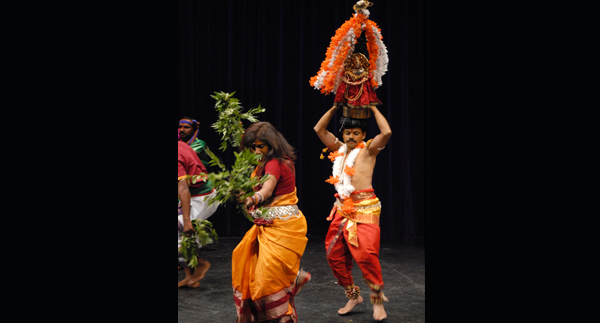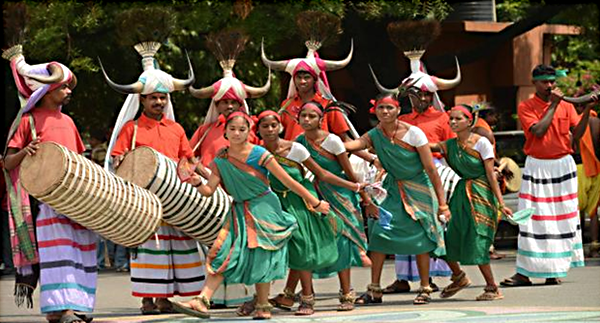
Now their descendants are mainly practicing agriculture. ‘ Sozhi josiam’ or prediction using the fall of cowrie shells and exorcism are other occupations of these people. These fortune-tellers are usually from the Kambala Nayakar community. In Tamil Nadu, one must have noticed a ‘ Kuduguduppu Karan,’ a fortune teller with a ‘ udukkai’ (a small drum with a rattle ) saying, ‘ Nalla kalam porakkudu, Jakkamma solra,’ meaning – good fortune awaits, says Jakkamma. Their inhabitants usually live on pastoral areas and their occupations include hunting, cattle-rearing, and fortune-telling.

They worship Sakkadevi or Goddess Jakkamma as their main deity. One such community is the Kambala Nayakar community. They settled in areas in and around the districts of Madurai, Ramanathapuram, Dindugal, Theni, Tiruchirapalli, Salem, Dharmapuri, and Coimbatore ruled by the Nayaks. After the fall of Vijayanagara empire to Muslim invaders, many Telugu-speaking communities migrated further south from the Bellary district, now in Karnataka. Their mother tongue was Telugu and were staunch Vaishnavites. HistoryĪreas of present-day Tamil Nadu were under the control of Nayaks, generals of the Vijayanagara empire in the 16 th century. It is a dance form that is deeply rooted within the Kambala Nayakar community, a Telugu-speaking community who settled in Tamilagam in the sixteenth century. The central theme of the dance is Rasa Lila of Krishna and her abode Radha.The dance of the Gods or the Devas is Devaraattam. Rural people represent the dance with great enthusiasm wearing traditional hats and costumes. It is an important folk dance performed in the Dhamtari district of the state. The Rahas dance is performed during festivals in Chhattisgarh. The dancers are mounted on two long bamboo poles or on any firm pole and also maneuver through the crowd of other Gendi (pole) mounted dancers.īanging on the ground, keeping an excellent balance while swaying with tribal acoustics and percussions.įurther, this is an amazing folk dance that has managed to keep its tradition alive. In all of the dance forms, Gendi is pure fun. Similarly, they dance in circles in front of all the houses in the town, after which they are given ration as a sign of gratitude for the dance and yes,īur Its genuine effect can as it was be seen to be experienced! So, Their faces become nothing less than a canvas with chalk, charcoal, and powdered rangoli spread on it. Halloween is a ritual, it is also played by children in the Bastar region.ĭuring the sun goes down, the children dress in rags and worn-out costumes. One of the famous Bastar dance is a Jhirliti.īut, A lesser-known dance form, is difficult to classify as an established dance form due to the lack of a fixed pattern. It is a strong belief that during the auspicious ‘tithi’ the god is awake. The dance is performed on ‘dev udhni Ekadashi’. It reinforces the ancient truth of the triumph of good over evil.Īs maintained by the Hindu calendar, it is celebrated on the 11th day after Deepawali. But The cowboy Yadavs well represent Lord Krishna as their almighty. Therefore, the scenes show the fierce fight between King Khansa and the cowboys in that area. The Yadava / Yaduvanshis, a Chhattisgarh caste, are considered descendants of Krishna. However, Chhattisgarh’s cowboys are the main artists of it. Likewise, A group of men builds a pyramid formation as the group leader sings.Ī famous dancer of this dance was the late Devdas Banjare. Moreover, The dancers wear colorful dresses and sing praises to the “guru”.

The dance also combines a variety of steps and patterns and generally denotes the teachings and sayings of its holy master. The rich cultural heritage and traditional legacies of the tribal groups. The community also celebrates the anniversary of the birth of Guru Ghasidas in Maghi Purnima. This Dance is one of the most vital forms of folk dance in this locale.Ī prominent custom of the Satnami community of Chhattisgarh. She has also received various awards like Padma Shri, Padma Bhushan, etc. Teejan Bai from Chhattisgarh is one of Pandvani’s most famous artists. It is the dark horse of the Chhattisgarh folk dance.īut, Portray the account of Pandavas, the main characters of an epic battle. Parrot represents Lord Shiva and Goddess Parvati.įamous poet Mukutdar Pandey gives the title of “Garba of Chattisgarh”. The women perform this dance and while doing so, keep a clay parrot in the center. The artists also sing and move, accompanied by loud applause. Women of the devaar tribe perform this dance.

So, During Goura’s wedding and Diwali, this dance is performed. The unexplored beauty of the region is complete without the camaraderie of tribal popular culture.

This dance form marks the end of the rainy season and the advent of spring.īoth men and women participate in the dance following a lead singer. Generally performed by tribal groups like Gonds, Baigas, and Oraons in Chhattisgarh.


 0 kommentar(er)
0 kommentar(er)
